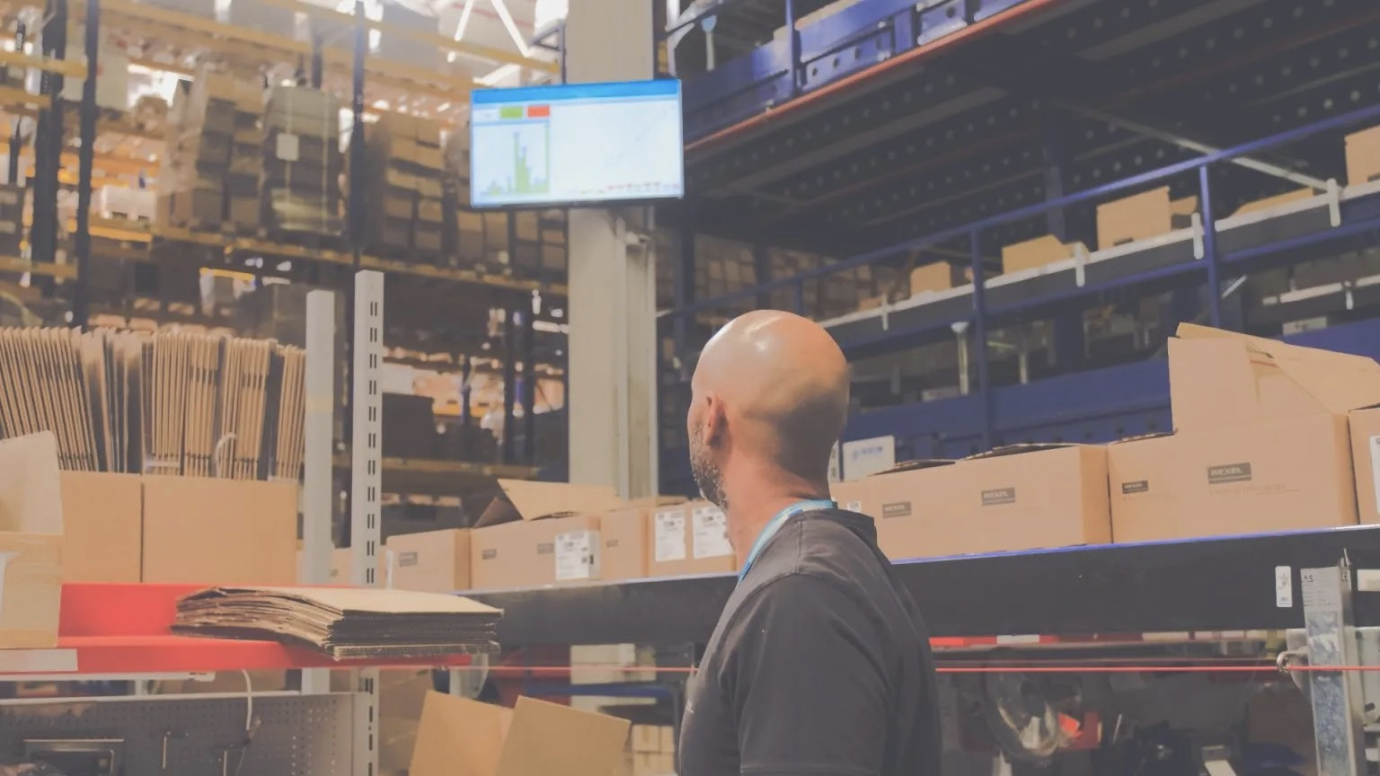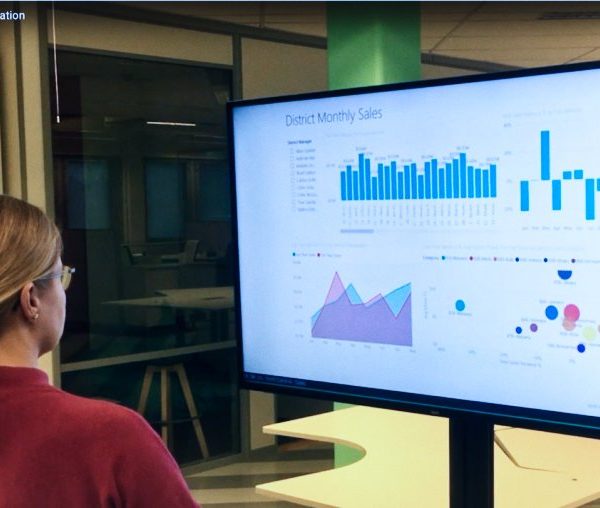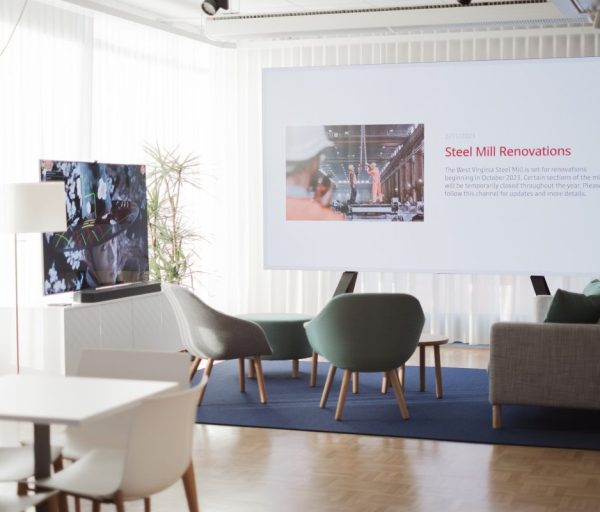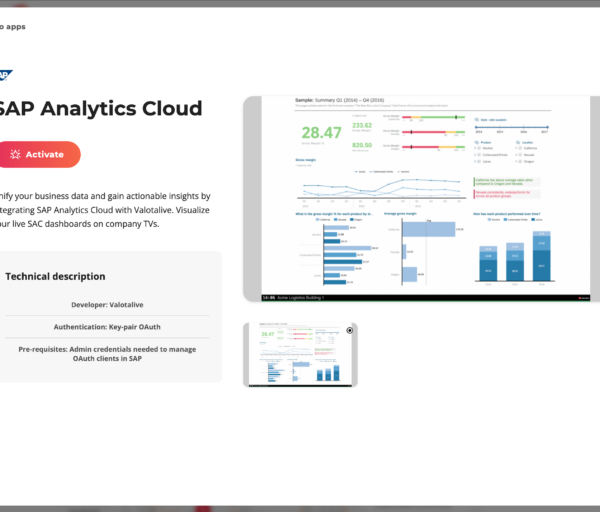With years of experience working with companies implementing Workplace Digital Signage, we have analyzed the common challenges, requirements, and objectives that drive their adoption.
Based on these insights, we’ve compiled a comprehensive study summarizing the key aspects of Workplace Digital Signage.
Summary:
- Workplace digital signage involves using technology to display digital content on screens within a company or organization.
- It aims to overcome challenges posed by outdated communication methods that often lead to information silos and reduced employee engagement, particularly for non-desk workers.
- Businesses across diverse industries are adopting workplace digital signage to enhance internal communication, boost employee engagement, and improve operational efficiencies by displaying KPIs, news, and updates on strategically positioned screens.
- Effective workplace digital signage solutions typically feature a centralized platform, capabilities for targeted messaging, real-time updates via integrations with business applications, and tools for shop floor meetings and managing tier boards.
- Implementing workplace digital signage requires careful consideration of the target audience, objectives, content strategy, potential integrations, and necessary resources, with an emphasis on choosing software that supports automated content updates and aligns with company needs.
Table of Contents:
- The Term
- The Challenge
- Workplace Digital Signage Case Examples
- Key Needs for Workplace Digital Signage
- Workplace Digital Signage Components
- Business Impact
- The Story Behind the Term Workplace Digital Signage
The Term
The term “Workplace Digital Signage” is a combination of two words:
- Workplace: This refers to the environment where digital signage is used, specifically within a company or organization.
- Digital Signage: This is the technology that displays digital content on screens.
When combining “Workplace” and “Digital Signage,” we get “Workplace Digital Signage,” which specifically refers to the use of digital display technology within a company or organization’s premises to communicate various types of digital content.
The Challenge
In today’s fast-paced business environment, effective communication is essential for driving efficiency and success. However, many companies struggle with outdated communication channels that fail to reach all employees, especially those working outside of traditional office settings. This can lead to information silos, misunderstandings, and decreased employee engagement.
Non-desk workers, such as those in production facilities and customer-facing roles, often rely on timely information to make informed decisions.
According to a 2020 report, by Emergence, non-desk (deskless) workers sum up to 80% of the global workforce.
Unfortunately, traditional communication methods like email and bulletin boards can be slow, unreliable, and difficult for non-desk employees to access.
Workplace Digital Signage has emerged as a powerful solution as businesses seek to address these challenges.
Workplace Digital Signage Case Examples
Companies in manufacturing, logistics, and other industries with dispersed workforces are increasingly turning to workplace digital signage as a powerful tool to reach all employees, regardless of their location or role.
These companies want to improve internal communication (reach all people), enhance employee engagement, and drive operational efficiencies.
Here are some examples from different industries:
Logistics
Warehouses and distribution centers often employ a large workforce of on-site personnel. Given the often hazardous nature of warehouse and distribution center environments, effective communication is critical for ensuring workplace safety preventing accidents, and maintaining high-quality standards in operations.
Case Rexel
Rexel, with headquarters in Paris, France is an expert in multichannel distribution for the energy world. The company has been listed on the Paris Stock Exchange.
Rexel is using Valotalive Workplace Digital Signage to improve quality and employee communication.
Thomas Grüner, Project Manager, Logistics at Rexel says “Rexel is using Valotalive digital signage software to Improve quality and employee communication in their distribution center in Germany.
We found the service very easy to use and are benefiting from the integrations with Microsoft applications, such as Power BI as an example.”
Retail
Retail is an industry with a significant number of frontline employees. As an example Irregular shift patterns can make it challenging for frontline employees to stay informed and connected during the day.
Case Puuilo
Puuilo is a Finnish retail store chain, known in particular for its wide product assortment, low prices, good store locations, and convenient shopping experience. Puuilo has over 40 stores.
Puuilo was looking for a new communication channel to reach all front-line workers with company messaging.
“Internal communication in retail is both demanding and highly important. Valotalive digital signage is a powerful communication tool to keep all employees engaged and updated during busy workdays.
The modern platform allows us to automatically pull the content from the applications we use a lot such as Microsoft SharePoint and Teams. This automation saves a lot of time while offering a true multi-channel employee communication solution for our employees.”, says Juha Parviainen, CIO of Puuilo.
Manufacturing

Manufacturing is an industry where a significant workforce of production employees are working on the factory floor.
Similar to the logistics industry, effective communication is essential in manufacturing for ensuring workplace safety, preventing accidents, and maintaining high operational standards.
Case Neste
Neste is the world’s leading producer of sustainable fuels and renewable feedstock solutions for various polymers and chemical industry uses. The company has a turnover of 22.9 Billion euros (2023)
Safety is a top priority for Neste, aligned with their core value We Care “We care for each other’s wellbeing and safety”.
“The real-time and transparent KPIs guide our operation in a positive direction.
The biggest benefit in these visualized indicators has been that the company’s key targets are made visible to everyone.” said Jatta Pakkanen, Communication Officer, Neste
Key Needs for Workplace Digital Signage
In summary, our study identified the following key needs among these and other companies seeking to enhance internal communication through Workplace Digital Signage:
1 Centralized communication platform
A centralized, user-friendly platform was required to distribute messages across multiple TV screens or displays, reaching all employees regardless of their location. By displaying key performance indicators (KPIs), news, updates, and announcements on screens in convenient locations, these companies made information easily accessible and digestible for all employees.
2 Targeted messaging
The companies for looking for the ability (a solution) to deliver targeted messages to specific groups or individuals based on their roles, departments, or locations.
Workplace Digital Signage offers this capability by allowing screens to be grouped by geographical location, business unit, or individual location. This enables precise targeting of information to specific screen groups, individual screens, or any level in between.
3 Real time updates
Given the critical role of timely information in enabling non-desk workers to make informed decisions, real-time or near-real-time updates are essential for effective Workplace Digital Signage solutions.
This functionality is enabled through integrations between the Workplace Digital Signage platform and business applications like Microsoft Power BI, SAP Analytics Cloud, Microsoft SharePoint, Google Sheets, or other relevant enterprise software.
4 A Tool for Shop Floor Meetings & Managing Tier Boards
Line managers often require flexibility to deliver presentations and safety videos directly on the shop floor during shift changes. Additionally, there is a growing demand for digital shop floor boards, also known as Tier Boards, to provide a comprehensive overview of operations and streamline communication within production environments
Workplace Digital Signage Components
Before diving into the solution and its components, it’s essential to carefully consider the following elements of your plan:
- Target Audience: Identify the specific groups or individuals you want to reach with your Workplace Digital Signage solution.
- Goals and Objectives: Clearly define the desired outcomes and benefits you aim to achieve through implementation.
- Content and Integrations: Assess the possibility of automating content updates from your existing business applications.
- Resources: Identify the necessary personnel and support functions, including ownership and IT involvement.
After having said that, let’s jump in:
1 Workplace Digital Signage Software
While display size and media player brand are important considerations, the most critical decision is selecting software that aligns perfectly with your company’s needs in terms of features, integrations, and security.
A key decision factor is the ability to seamlessly integrate with business applications like BI or ERP systems, company intranet software, and productivity tools. This integration is crucial for automating content updates and delivering real-time information.
For companies with non-desk workers, interactive and flexible features for Tier Boards and shop floor meetings are essential. Workplace Digital Signage solutions that enable real-time updates, targeted messaging, and collaboration tools can significantly enhance these critical communication channels.
Remember the 70/30 rule 👇🏼
For optimal success, we recommend a content strategy where at least 70% of updates are automated, such as KPIs or data feeds, while the remaining 30% can be manually updated with more dynamic or personalized content.
2 TV or Display
Types: LCD, LED, or sometimes touchscreen displays are commonly used.
Size: Choose a size that is appropriate for your viewing distance and the desired impact.
Resolution: Higher resolution displays offer better image quality and sharper text.
Brightness: Ensure the display is bright enough for your environment, especially if it will be used in areas with high ambient light.
3 Mediaplayer
Standalone or integrated (SOC/built-in): Some displays have built-in media players, while others require a separate unit. This is a mini PC that will be placed behind the screen or out of site. This will connect your display to the Workplace Digital Signage Software (cloud).
Performance: Consider the media player’s processing power and storage capacity to handle demanding content.
Some of the most used media players are running on Windows or ChromeOS
Additional Considerations:
Legacy Equipment: Using a separate media player offers flexibility for incorporating existing TVs or screens into your digital signage network.
Future Expansion: As your network grows, you can, as an option, gradually upgrade to more modern displays with built-in media players, allowing for further cost savings and simplified management.
4 Centralised Hardware Management
While centralized hardware management isn’t strictly necessary for basic functionality, it’s important for ensuring system updates, managing software, and maintaining optimal performance.
Device Management Options:
- Chrome Device Management: For ChromeOS devices.
- Intune (or other): For devices running on Microsoft Windows.
- Remote Management Tool: Essential for displays with built-in media players (also known as SOC displays).
Benefits of Remote Device Management:
- Consistent Policies: Ensures that security policies and other settings are aligned across the entire network.
- Automated Updates: Manages OS updates efficiently.
- Troubleshooting: Enables remote rebooting and supervision in case of issues
Read more about centralised hardware management here: Digital Signage Device Management Explained.
Business Impact
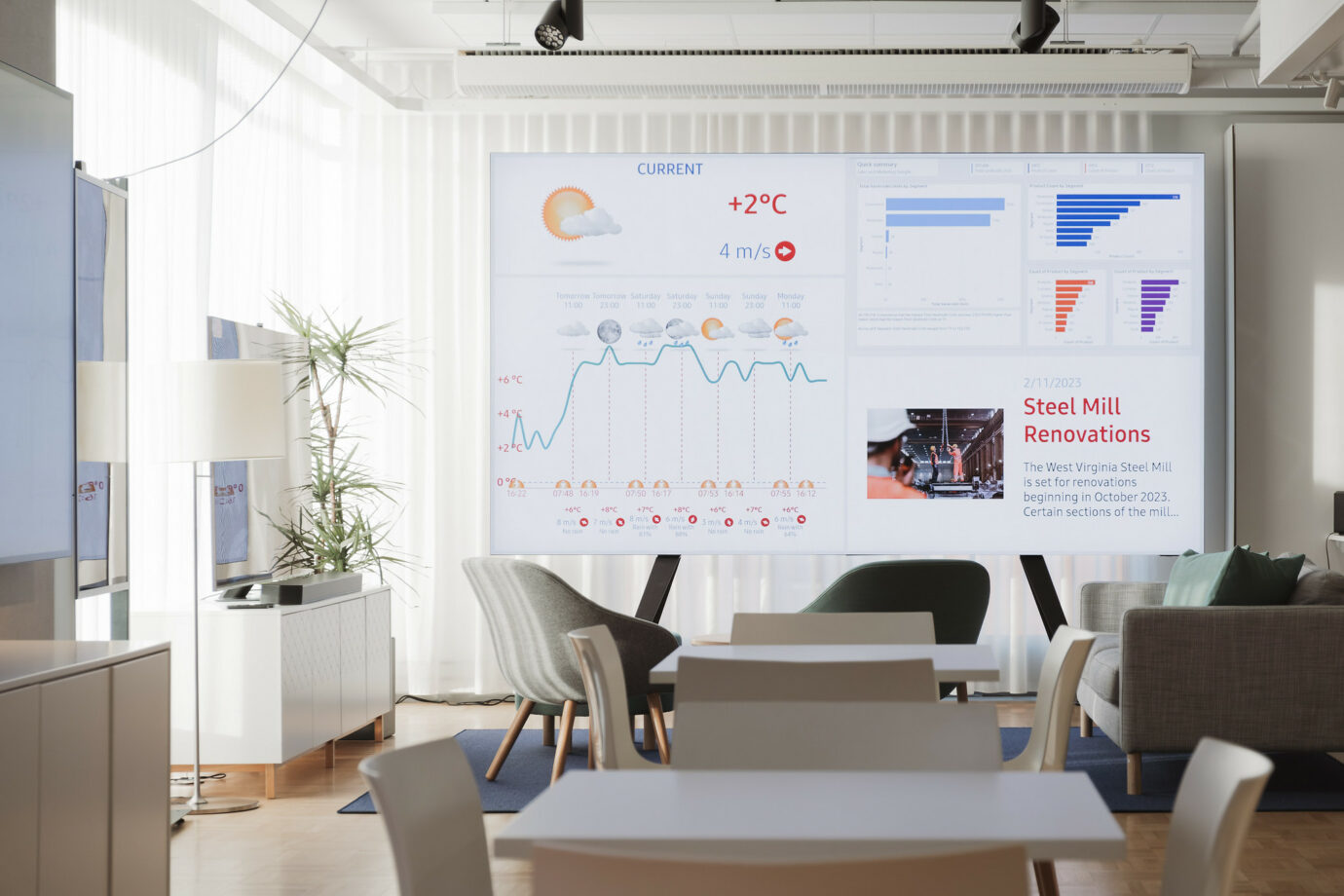
As stated before Workplace Digital Signage delivers significant business benefits by:
Driving operational efficiencies: Streamlining processes, improving decision-making, and reducing errors through real-time information and targeted messaging.
Enhancing internal communication: Reaching all employees, regardless of location or role, to ensure timely and consistent information sharing.
Boosting employee engagement: Creating a more connected and informed workforce, leading to increased morale, productivity, and job satisfaction.
This versatile tool can be leveraged by a wide range of managers and top executives, including those in
- Health and Safety
- Business Intelligence
- Quality
- Operations
- Internal Communication
- Human Resources and others
Read more about Business Impact here: Digital Bulletin Board: Unleashing the Power of Workplace Digital Signage
The Story Behind the Term Workplace Digital Signage
While the exact origin of the term is unclear, Valotalive played a role in its traction by using it in the marketing and branding efforts in the early days (2017).
The popularity of the term “Workplace Digital Signage” can be connected to its clarity and relevance to the target audience. It effectively conveys the purpose and application of this technology within corporate environments.
